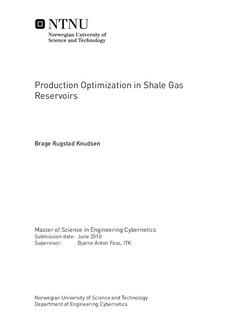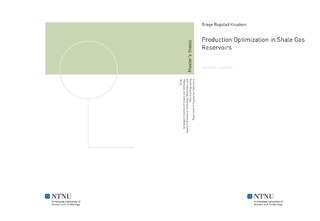| dc.contributor.advisor | Foss, Bjarne Anton | nb_NO |
| dc.contributor.author | Knudsen, Brage Rugstad | nb_NO |
| dc.date.accessioned | 2014-12-19T14:02:25Z | |
| dc.date.available | 2014-12-19T14:02:25Z | |
| dc.date.created | 2010-09-04 | nb_NO |
| dc.date.issued | 2010 | nb_NO |
| dc.identifier | 348957 | nb_NO |
| dc.identifier | ntnudaim:5380 | nb_NO |
| dc.identifier.uri | http://hdl.handle.net/11250/259951 | |
| dc.description.abstract | Natural gas from organic rich shales has become an important part of the supply of natural gas in the United States. Modern drilling and stimulation techniques have increased the potential and profitability of shale gas reserves that earlier were regarded as unprofitable resources of natural gas. The most prominent property of shale gas reservoirs is the low permeability. This is also the reason why recovery from shale gas wells is challenging and clarifies the need for stimulation with hydraulic fracturing. Shale gas wells typically exhibit a high initial peak in the production rate with a successive rapid decline followed by low production rates. Liquid accumulation is common in shale wells and is detrimental on the production rates. Shut-ins of shale gas wells is used as a means to prevent liquid loading and boost the production. This strategy is used in a model-based production optimization of one and multiple shale gas well with the objective of maximizing the production and long-term recovery. The optimization problem is formulated using a simultaneous implementation of the reservoir model and the optimization problem, with binary variables to model on/off valves and an imposed minimal production rate to prevent liquid loading. A reformulation of the nonlinear well model is applied to transform the problem from a mixed integer nonlinear program to a mixed integer linear program. Four numerical examples are presented to review the potential of using model-based optimization on shale gas wells. The use of shut-ins with variable duration is observed to result in minimal loss of cumulative production on the long term recovery. For short term production planning, a set of optimal production settings are solved for multiple wells with global constraints on the production rate and on the switching capacity. The reformulation to a mixed integer linear program is shown to be effective on the formulated optimization problems and allows for assessment of the error bounds of the solution. | nb_NO |
| dc.language | eng | nb_NO |
| dc.publisher | Institutt for teknisk kybernetikk | nb_NO |
| dc.subject | ntnudaim | no_NO |
| dc.subject | SIE3 teknisk kybernetikk | no_NO |
| dc.subject | Reguleringsteknikk | no_NO |
| dc.title | Production Optimization in Shale Gas Reservoirs | nb_NO |
| dc.type | Master thesis | nb_NO |
| dc.source.pagenumber | 112 | nb_NO |
| dc.contributor.department | Norges teknisk-naturvitenskapelige universitet, Fakultet for informasjonsteknologi, matematikk og elektroteknikk, Institutt for teknisk kybernetikk | nb_NO |

